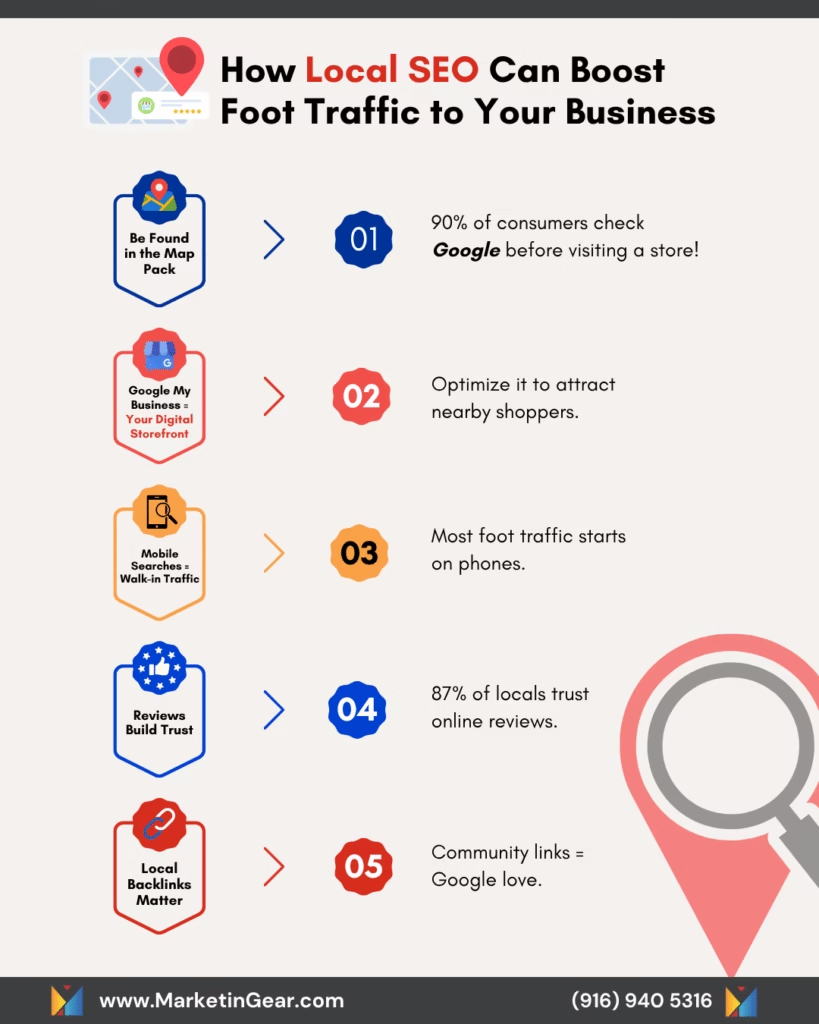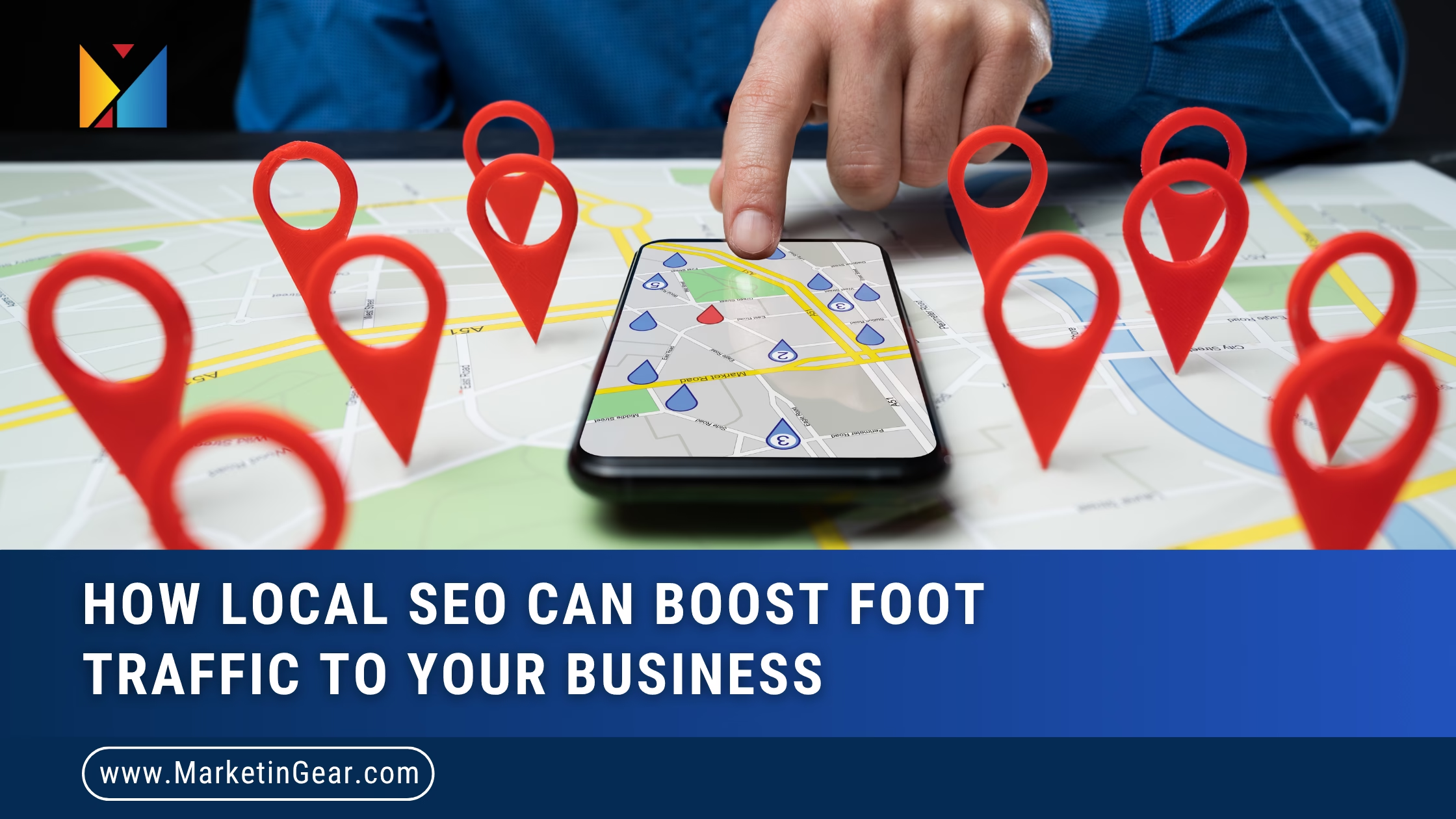Introduction: From Clicks to Customers
Imagine this: someone’s wandering through the city, craving a great cup of coffee. They whip out their phone, type “best coffee near me,” and seconds later, Google delivers a curated list. What do they do next? They choose the first place with great reviews, click “directions,” and walk right in.
That’s the magic of local SEO in action.
In 2025, simply having a website or a business profile isn’t enough. Your online presence needs to be visible, optimized, and geo-relevant. If you’re not ranking for local searches, your business might as well be invisible.
Local SEO isn’t just an online tactic—it’s a real-world game-changer. Whether you run a bakery, salon, law firm, or pet grooming business, showing up in the right searches turns digital intent into physical foot traffic.
In a world where over 80% of mobile users depend on their phones to discover nearby services, climbing those local search results can be the difference between a booming business and a quiet storefront.
Let’s break down exactly how to use local SEO to go from getting clicks to getting customers through your door.

1. What is Local SEO (and Why It’s Not Just for Techies)
Local SEO is all about showing up when it matters most—when someone nearby is actively looking for what you offer.
It focuses on search terms with local intent—phrases like:
- “best coffee shop near me”
- “emergency plumber in [city]”
- “kids clothing store downtown Chicago”
These aren’t random clicks—they’re customers ready to buy.
Why Local SEO Works:
Google’s algorithm considers proximity, relevance, and prominence when showing local businesses. Local SEO helps you optimize all three:
- Proximity: How close the searcher is to your business
- Relevance: How well your business matches the search query
- Prominence: How well-known and trusted your business is online (reviews, backlinks, etc.)
You don’t need to be a coder or SEO expert—just someone who wants to be found when locals are searching.
2. Claim and Optimize Your Google My Business (GMB) Profile
Your GMB profile is your storefront on Google—and it’s free
How to Make It Irresistible:
- Complete every field: Name, address, phone number (NAP), hours, website, and categories.
- Upload vibrant photos of your storefront, menu, team, and happy customers.
- Encourage reviews: GMB reviews boost credibility and rankings.
- Use local keywords: “Affordable haircuts in South Sacramento” is more powerful than just “haircuts.”
- Post regular updates: Promote events, offers, or seasonal sales directly on your GMB.
Pro tip: Google favors listings that are active, accurate, and engaging.
3. Use Location-Based Keywords on Your Website
Generic keywords won’t cut it. You need keywords tailored to your location.
Instead of saying:
“We bake the best cupcakes.”
Say:
“Award-winning cupcakes in downtown Austin, TX.”
Smart Places to Add Local Keywords:
- Website homepage and service pages
- Page titles and meta descriptions
- Blog posts about local events or topics
- Image alt tags and filenames
- Anchor text for internal linking
Think like a local customer: “What would I type if I wanted to find this service right now?”
4. Get Local Backlinks (They Matter More Than You Think)
Backlinks = trust signals. Local backlinks = trust + location relevance.
How to Build Local Backlinks:
- Join your local chamber of commerce (they often link to members)
- Submit press releases to local news outlets
- Collaborate with schools or non-profits (sponsor a school event or community cleanup)
- Cross-promote with other small businesses on blogs or social media
Even “small” links from local organizations can make a big impact in your local SEO authority.
5. Encourage Reviews That Actually Drive Foot Traffic
Positive reviews = proof you deliver. They also increase your visibility in local search.
Tips to Get More Quality Reviews:
- Ask immediately after purchase—in person or via email
- Display QR codes on receipts, bags, or windows
- Train staff to mention reviews during checkout
- Offer a gentle incentive: “Leave a review and get 10% off next time!”
Don’t forget to reply to every review (even negative ones) to show you care and are engaged.
6. Add Local Content That Builds Trust
Google loves fresh content. Customers love authentic, local stories.
Local Content Ideas:
- Blog about neighborhood events or festivals
- Highlight partnerships with local charities
- Share behind-the-scenes of your business in the community
- Feature loyal customers or community stories
This signals that you’re not just selling—you’re serving the neighborhood.
7. Make Sure Your Website is Mobile-Friendly (Like, Seriously)
If your site takes more than 3 seconds to load on a phone, you’re losing visitors.
Mobile Optimization Checklist:
- Fully responsive design that adapts to screens
- Clickable phone number and address
- Page load speed under 3 seconds
- Easy, thumb-friendly navigation
- Compressed images for speed without quality loss
Why it matters: Over 70% of local searches happen on mobile. A bad mobile site = a lost customer.
8. Use Social Media with Location Tags
Social media is free local advertising—if you use it right.
Boost Visibility with:
- Geotags on Instagram, TikTok, and Facebook posts
- Behind-the-scenes reels from your store
- Customer shoutouts with location tags
- Event promotions with your business tagged as the venue
The more you post from your location, the more local users will discover you.
9. Use Google Posts to Attract Walk-Ins
Did you know you can create mini-posts right inside your GMB listing?
What to Share:
- Weekly specials or flash sales
- Upcoming in-store events
- Featured products or services
- Holiday or seasonal deals
These posts appear in search results—great for grabbing last-minute traffic!
10. Track What’s Working with Local SEO Analytics
Without data, you’re just guessing.
Tools to Monitor Progress:
- Google Business Profile Insights: See how many people viewed, called, or got directions
- Google Search Console: Track keyword impressions, clicks, and page performance
- Ubersuggest or Moz Local: Track keyword rankings and audit your local SEO health
Review your metrics monthly and adjust. Double down on what brings in clicks and customers.
🏁 Conclusion: From Digital to Doorstep
Local SEO is the invisible bridge between your online presence and real-world revenue.
It’s not about flashy ads or viral videos—it’s about being present when your community needs you most. By optimizing your listings, engaging locally, and speaking your audience’s language, you’ll turn searches into foot traffic and customers into regulars.
You don’t need to be a tech wizard—just someone who wants to be seen, trusted, and visited. And with the tools in this guide, you’re more than ready.
Start small, stay consistent, and remember: local SEO isn’t a hack—it’s a long-term growth engine for small businesses ready to thrive.




